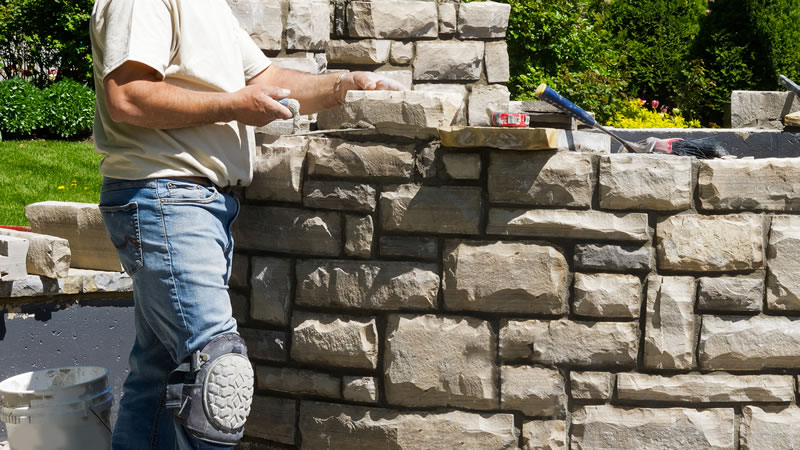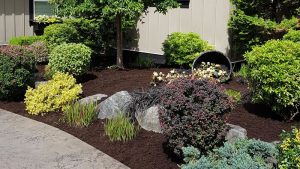
Retaining Wall Solutions For Sloped Properties in Vancouver
We specialize in building beautiful and functional retaining walls.
Retaining walls are a great way to enhance both the look and function of your landscaping. Commonly used as a solution for sloping and uneven properties, retaining walls let you carve out functional outdoor spaces into sloping properties that can be suitable for new patio areas, sections of lawn, new garden areas, parking pads, and more. Made out of a variety of building materials retaining walls can compliment your landscaping and increase your properties curb appeal.
Why Do You Need A New Retaining Wall?
- Do you have a steep slope you’d like to reclaim?
- Do you have an existing retaining wall that is failing?
- Are you trying to prevent erosion on your property?
All Scapes Property Services is a full service landscaping contractor based out of Langley and serving Greater Vancouver. We specialize in the design and construction of retaining walls using rock, block, and boulders for both residential and commercial property owners. From a 35′ foot long stacked block retaining wall to hold back a garden or the edge of your driveway to large terraced retaining walls on your sloping property. The team at All Scapes Property Services will be able to provide retaining wall solutions that will benefit your specific property.
Retaining Walls & Building Permits in Vancouver
In the Metro Vancouver area retaining walls that are 4ft in height or over will generally require a building permit. In addition any retaining walls over 4 feet in height must be designed and signed off by a structural engineer to ensure the wall is properly constructed for your site conditions. An exception applies to the permit for “terraced or tiered” retaining walls where the distance between terraces is equal to or greater than twice the height of each terrace. This does not account for any covenants that might be on your property.
Each municipality can have their own specific by-laws for the construction of retaining walls so it’s important to discuss your project with a professional so you can quickly find out what you can or cannot do with regards to a retaining wall on your property.
Retaining Walls and Proper Drainage
While retaining walls are designed and built to hold back earth and fill they will also hold back and channel water. The water that builds up behind a retaining wall is referred to as “hydrostatic pressure” and the external force of the material/fill held behind your wall coupled with the weight of the water is often enough to seriously compromise the integrity of your wall and even cause failure and collapse.
A good drainage system should be an integral part of any retaining wall design. Depending on the type of material being used to build the wall there are a variety of ways to integrate sufficient drainage such as weep holes, lateral drains, blanket drains and also the use of very granular soil or fill.
Don’t underestimate the external forces that are being applied to your retaining wall as there are many retaining walls throughout our area that have failed due to poorly thought out or non-existent drainage. Don’t let your contractor make this mistake!
Retaining Wall Material Choices
There are many different materials to build your retaining wall from, we’ve just listed some of the more popular in our area because of their availability. If you have an idea for a retaining wall and you’d don’t see the materials listed here please give us a call or use our contact form and we’d be happy to source them for you.
Gravity or “Lock” Block: These are a very popular retaining wall choice for large retaining walls either spanning for a great distance or over several terraces.
The large rectangular concrete blocks are stacked on top of each other and through gravity and the eventual settling of the surrounding soil they make an excellent retaining wall. Locking concrete blocks are obviously very heavy and can only be moved using heavy machinery which can add significant cost to the project even though the blocks themselves are relatively inexpensive.
Boulder Retaining Walls: Boulders make a very strong statement and much like gravity blocks their sheer size is what gives them an edge as retaining wall construction material.
The natural look of stone if appealing and no two boulders will be alike giving you a very unique appearance to your wall. Boulders are purchased by the ton and are available in good supply locally. The boulders are affordable to buy but the real cost comes with their handling as retaining walls built with boulders will also require the use of heavy machinery to move and place the boulders which will significantly add to the cost of your project.
Landscaping Block Retaining Walls: This is probably one of the most common retaining wall materials because of it’s pleasing looks, availability and affordability. Landscaping blocks are usually used to build retaining walls that are under 3′ – 4′ feet in height. They are available in different shapes with decorative colors and even texturing.
The stackable blocks or stones are made of concrete and usually have a decorative finish on the front side and then a small lip on the back. The lip fits into the block below it to form an interlocking joint that can withstand the external forces of your soil and fill pushing against it. The blocks are often slightly wedge shaped to make it easier to create curved retaining wall designs.
Fieldstone Retaining Walls: This style of retaining wall is very popular for it’s aesthetically pleasing looks (it’s pretty tough to beat the looks of a natural stone wall!). Fieldstone retaining walls are not necessarily the best choice for very high retaining walls because they are simply too light of a material to hold back that much earth.
They are however an excellent choice for retaining walls that are small and more decorative in nature. There is a wide variety of fieldstone available locally and they can come in various shapes and sizes from round river rock style stones to very flat, flagstone type stones.
How Our Retaining Wall Construction Process Works
When building a retaining wall on your property that is designed to hold back tons of soil and earth there is very little margin for error so we work directly with a structural engineer or we use an engineered retaining wall system if your wall is over 1.2 meters (or 4 feet) in height.
- We start with our initial consultation.
- We determine how many feet of retaining wall you need.
- We determine the height of the wall and if a building permit or engineer will be required.
- We consult with you on the materials you’d like your retaining built with.
- We’ll provide you with an accurate written estimate for the work.
The amount of work required to build a retaining wall can vary widely from project to project. The slope of your property, the amount of earth your retaining wall must hold back and the overall accessibility of your property will all contribute to the final cost.
We’ll be able to offer you an accurate estimate only after a site visit.
Remember: Retaining walls that are in excess of 1.2 meters in height (4 ft) will require a building permit and must be designed by a geotechnical engineer or we must an engineered retaining wall system. We are more than happy to arrange and organize complicated projects such as this.
Why Choose All Scapes Property Services For Retaining Wall Construction?
We understand that you have many landscaping contractors to choose from throughout Metro Vancouver. We just want you to know that when you choose to work with All Scapes Property Services you are partnering with a small, locally owned business that has many years of experience implementing retaining wall solutions into properties just like yours.
You can expect knowledgeable, reliable service from our employees and a company that cares about your properties appearance and our local reputation.
If you’d like to get the process started then please give us a call (778) 366-2267 or fill out our online contact form and we’ll get back to you right away (usually the same day).
We can then organize a time for one of our landscaping experts to visit your property and assess it, take accurate measurements, answer any questions you might have about retaining walls and then provide you with a competitive estimate to build your new retaining wall.


